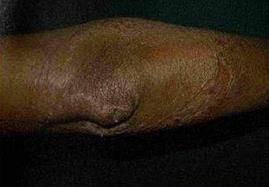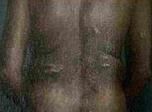Test: Hansen’s Disease - 1 - NEET PG MCQ
20 Questions MCQ Test Topic Wise MCQs for NEET PG - Test: Hansen’s Disease - 1
A patient of leprosy presents with lesions as shown. The likely diagnosis is:


A 45-year-old male had multiple hypoesthetic mildly erythematous large plaques with elevated margins on trunk and extremities. His ulnar and lateral popliteal nerves on both sides were enlarged. The most probable diagnosis is
Multiple hypoesthetic, hypopigmented macules on right lateral forearm with numerous acid-fast bacilli is indicative of:
A patient of leprosy presents with lesions as shown. The likely diagnosis is:

A known case of lepromatous leprosy was initiated on treatment. She devel- oped painful erythematous papules with fever and lymphadenopathy. What is the likely reactional state?
A 16-year-old student reports with multiple hypopigmented macules on trunk and limbs. All of the following tests are useful in making a diagnosis of leprosy except:
Under leprosy eradication programme the management of single lesion is:
|
97 tests
|














